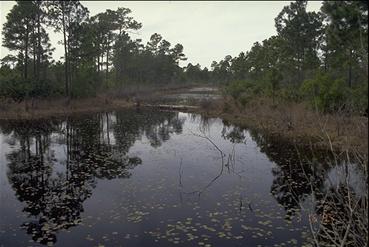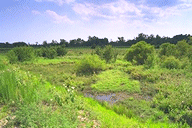 The characteristic features of many inland and coastal wetland systems - including dense vegetation, fallen trees, topography (hummocks, depressions), and the complexity of stream channel systems - can proivde a significant amount of water storage and frictional resistance to surface water flowing through wetlands during flood events. Inland wetlands adjacent to rivers, streams and creeks hold excess discharge and runoff during periods of increased precipitation such as tropical storms and hurricanes and during periods of rapid snow-melt in mountainous regions. Coastal wetlands also hold excess discharge from inland drainage networks as well as tidal waters during storms. Also, some water will be removed from the wetland through ground water recharge, soil retention and evapotranspiration. As a result, the flow of water is slowed, temporarily stored and then released slowly, decreasing the maximum flood flow (Tiner and Burke, 1995).
The characteristic features of many inland and coastal wetland systems - including dense vegetation, fallen trees, topography (hummocks, depressions), and the complexity of stream channel systems - can proivde a significant amount of water storage and frictional resistance to surface water flowing through wetlands during flood events. Inland wetlands adjacent to rivers, streams and creeks hold excess discharge and runoff during periods of increased precipitation such as tropical storms and hurricanes and during periods of rapid snow-melt in mountainous regions. Coastal wetlands also hold excess discharge from inland drainage networks as well as tidal waters during storms. Also, some water will be removed from the wetland through ground water recharge, soil retention and evapotranspiration. As a result, the flow of water is slowed, temporarily stored and then released slowly, decreasing the maximum flood flow (Tiner and Burke, 1995).
Functions & values
Several factors contribute to the ability of a wetland to provide stormwater and flood control:
1) the magnitude and duration of storm events,
2) the ability of upslope areas to retain and dissipate runoff,
3) the surface and subsurface storage capacity of the wetland,
4) the frictional resistance of the wetland (obstruction to flow),
5) the position of the wetland within the watershed, and
6) the size of the drainage area of the watershed relative to the watershed area.
 During flood events, wetlands perform important functions. These wetland functions have specific values for Marylanders.
During flood events, wetlands perform important functions. These wetland functions have specific values for Marylanders.
1. Decrease in the volume and velocity of flowing water VALUE - helps to prevent stream channel and shoreline erosion, and habitat destruction
2. Deposition and retention of fine sediment VALUE - helps to preserve water quality and aquatic ecosystems
3. Water storage by extending the period of time during which flood waters are released back to the drainage systems. VALUE - helps prevent flooding of homes, property, agricultural lands, and structures such as dams, bridges and roads
Sources
A Method for the Assessment of Wetland Function, Fugro East, Inc., 1995, for Department of Natural Resources
Wetlands of Maryland, Tiner and Burke, 1995, for U.S. Fish & Wildlife Service and Maryland Department of the Environment
A Comprehensive Nontidal Wetland Watershed Management Plan: A Guide for Local
Governments, Clearwater et al., 1998, for Maryland Department of the Environment